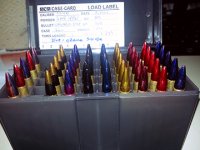You can still zero at 50 and, if you have a chronograph, get some velocities and velocity variation so that a ballistics program can predict your come-ups and how much vertical dispersion to expect at 300. However, there may also be a software package that will let you use 50 yards as described below, but I can't say for sure.
Creighton Auddette used to shoot his ladders at 200 yards, IIRC, and it was Randolf Constantine who pointed out 300 was showing the results a lot more clearly (though you don't want any significant wind when you shoot one, or you'll throw the results off). But at 200 yards you can still tell if you locate the holes with good precision and keep careful track of which shot made which hole. These days for hole location I use a $12 program called
OnTarget, scanning the target in, locating the holes, then using its export-to-Excel function to get each hole's X-Y coordinates. From there I can plot the vertical and horizontal coordinates against shot number and usually use a 5th order polynomial trend line to see where the flat spot in an Audette ladder lies. There is a free version of On Target, but I don't recall if it has the Excel export function. Perhaps someone else on the forum will know.
More apropos of your situation, there is also a much fancier $75 version of the software called OnTarget TDS, that has you print targets from its data base, and which it recognizes scans of and so can calibrate itself and then it locates the bullet holes automatically (the less expensive program relies on your eyeballs to center holes on the on-screen image using a 1 caliper circle). It is then is able to combine groups from several of these targets, score them, and it includes automatic OCW and Audette ladder evaluation (the OCW uses 3 shots per charge weight, where the Audette uses one). It keeps track of ladder holes by having you shoot only one shot onto each bull's-eye on a page full of small bull's-eyes, then combines the hole locations for evaluation. That software just may be able to see enough hole location even at 50 yards to give you an evaluation you can use. I haven't tried it, so I'm not at all sure, but the software has a free trial period of a few days, so you could
download it and try it out and see. The author may also have tried short ranges and could possibly tell you how well it worked out.

